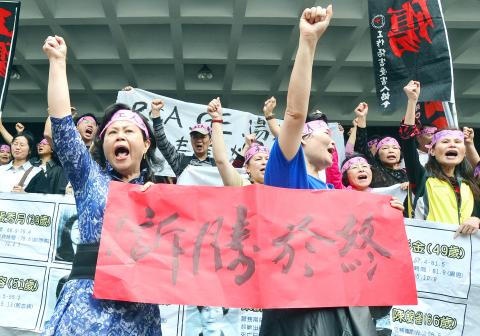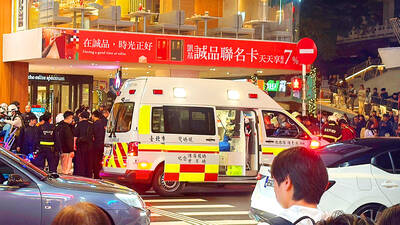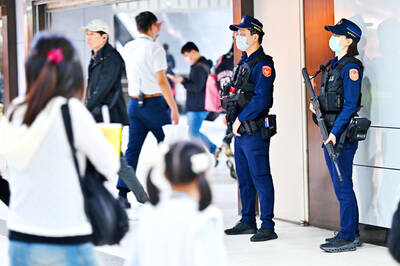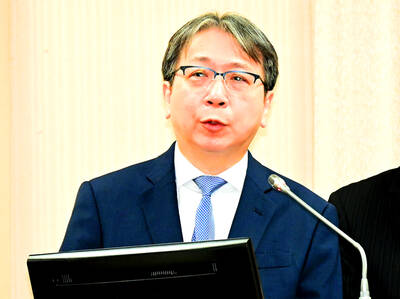Former employees of Radio Corp of America (RCA) burst into tears as a court yesterday ordered that the now-defunct electronics company and its owners pay NT$564.45 million (US$18.11 million) in damages to 445 former workers and their families.
With pink banners around their foreheads saying “RCA workers never give up,” about 60 members of the RCA Self-Help Association cheered their victory after the Taipei District Court handed down the ruling on the decade-long legal battle in what has been described as the worst industrial disaster in the nation’s history.
“During my time at RCA, we were often exposed to organic solvents. No one knew whether the substances were hazardous to our health,” said Huang Chun-tiao (黃春窕), 56, who was diagnosed with nasopharyngeal cancer after working at RCA for 18 years.

Photo: Wang Yi-sung, Taipei Times
According to the verdict, the defendants asserted that the plaintiff had failed to prove that the health issues resulted from exposure to environmental factors, but judges opined that the causal relationship could be determined with “a reasonable degree of medical certainty” to be the toxicity of the organic solvents.
RCA operated in Taiwan from 1970 to 1992, with plants in then-Taoyuan County, Hsinchu County, and Yilan County, employing tens of thousands of people in the production of color TVs and other electronics products using up to 31 kinds of organic solvent, including trichloroethylene and tetrachloroethene, exposure to which increases the risk of cancer, the verdict said.
In 1998, the Environmental Protection Administration (EPA) found that the site of the former RCA plant in Taoyuan was contaminated with chlorinated organic solvents and other toxic chemicals used in its production after the company had illegally dug wells to discharge the toxic waste, which contaminated tap water used by its workers and nearby residents.
The 7.2 hectare plant has been designated by the EPA as a site of “permanent contamination.”
During the period between 1992 when RCA shut down its plants in Taiwan and 2004 when 519 members of the association filed the civil lawsuit, more than 1,300 of RCA’s former employees have been diagnosed with various types of cancer, with 221 of them dying, the verdict said.
A year after the takeover of RCA by General Electric (GE) in 1986, the firm was sold to Thomson Consumer Electronics, the US subsidiary of France-based Thomson Multimedia, which is now called Technicolor SA.
The RCA Self-Help Association had sought damages of NT$2.7 billion from RCA, GE and Thomson, but the court absolved GE of any blame, a decision over which Joseph Lin (林永頌), the lead lawyer for the association, expressed regret.
Lin thanked the judges for determining that the effects of the pollutants caused the diseases, a rare decision in a Taiwanese case.
The defendants have the right to appeal the Taipei District Court’s verdict.

TRAGEDY STRIKES TAIPEI: The suspect died after falling off a building after he threw smoke grenades into Taipei Main Station and went on a killing spree in Zhongshan A 27-year-old suspect allegedly threw smoke grenades in Taipei Main Station and then proceeded to Zhongshan MRT Station in a random killing spree that resulted in the death of the suspect and two other civilians, and seven injured, including one in critical condition, as of press time last night. The suspect, identified as a man surnamed Chang Wen (張文), allegedly began the attack at Taipei Main Station, the Taipei Fire Department said, adding that it received a report at 5:24pm that smoke grenades had been thrown in the station. One man in his 50s was rushed to hospital after a cardiac arrest

PUBLIC SAFETY: The premier said that security would be tightened in transport hubs, while President Lai commended the public for their bravery The government is to deploy more police, including rapid response units, in crowded public areas to ensure a swift response to any threats, President William Lai (賴清德) said yesterday after a knife attack killed three people and injured 11 in Taipei the previous day. Lai made the remarks following a briefing by the National Police Agency on the progress of the investigation, saying that the attack underscored the importance of cooperation in public security between the central and local governments. The attack unfolded in the early evening on Friday around Taipei Main Station’s M7 exit and later near the Taipei MRT’s Zhongshan

SAFETY FIRST: Double the number of police were deployed at the Taipei Marathon, while other cities released plans to bolster public event safety Authorities across Taiwan have stepped up security measures ahead of Christmas and New Year events, following a knife and smoke bomb attack in Taipei on Friday that left four people dead and 11 injured. In a bid to prevent potential copycat incidents, police deployments have been expanded for large gatherings, transport hubs, and other crowded public spaces, according to official statements from police and city authorities. Taipei Mayor Chiang Wan-an (蔣萬安) said the city has “comprehensively raised security readiness” in crowded areas, increased police deployments with armed officers, and intensified patrols during weekends and nighttime hours. For large-scale events, security checkpoints and explosives

ON ALERT: Taiwan’s partners would issue warnings if China attempted to use Interpol to target Taiwanese, and the global body has mechanisms to prevent it, an official said China has stationed two to four people specializing in Taiwan affairs at its embassies in several democratic countries to monitor and harass Taiwanese, actions that the host nations would not tolerate, National Security Bureau (NSB) Director-General Tsai Ming-yen (蔡明彥) said yesterday. Tsai made the comments at a meeting of the legislature’s Foreign Affairs and National Defense Committee, which asked him and Minister of National Defense Wellington Koo (顧立雄) to report on potential conflicts in the Taiwan Strait and military preparedness. Democratic Progressive Party (DPP) Legislator Michelle Lin (林楚茵) expressed concern that Beijing has posted personnel from China’s Taiwan Affairs Office to its